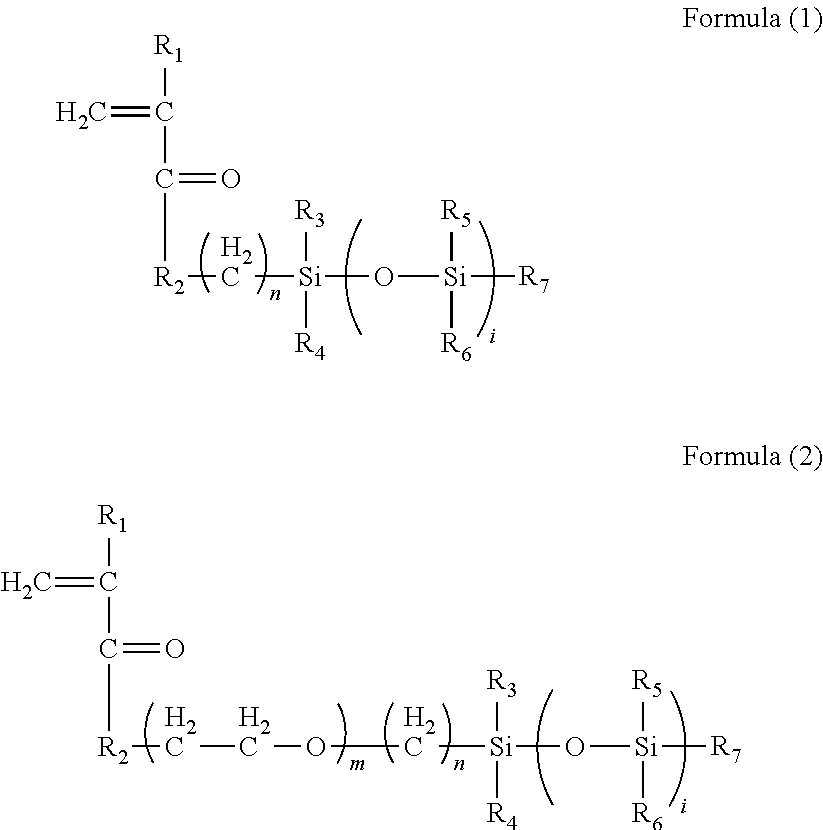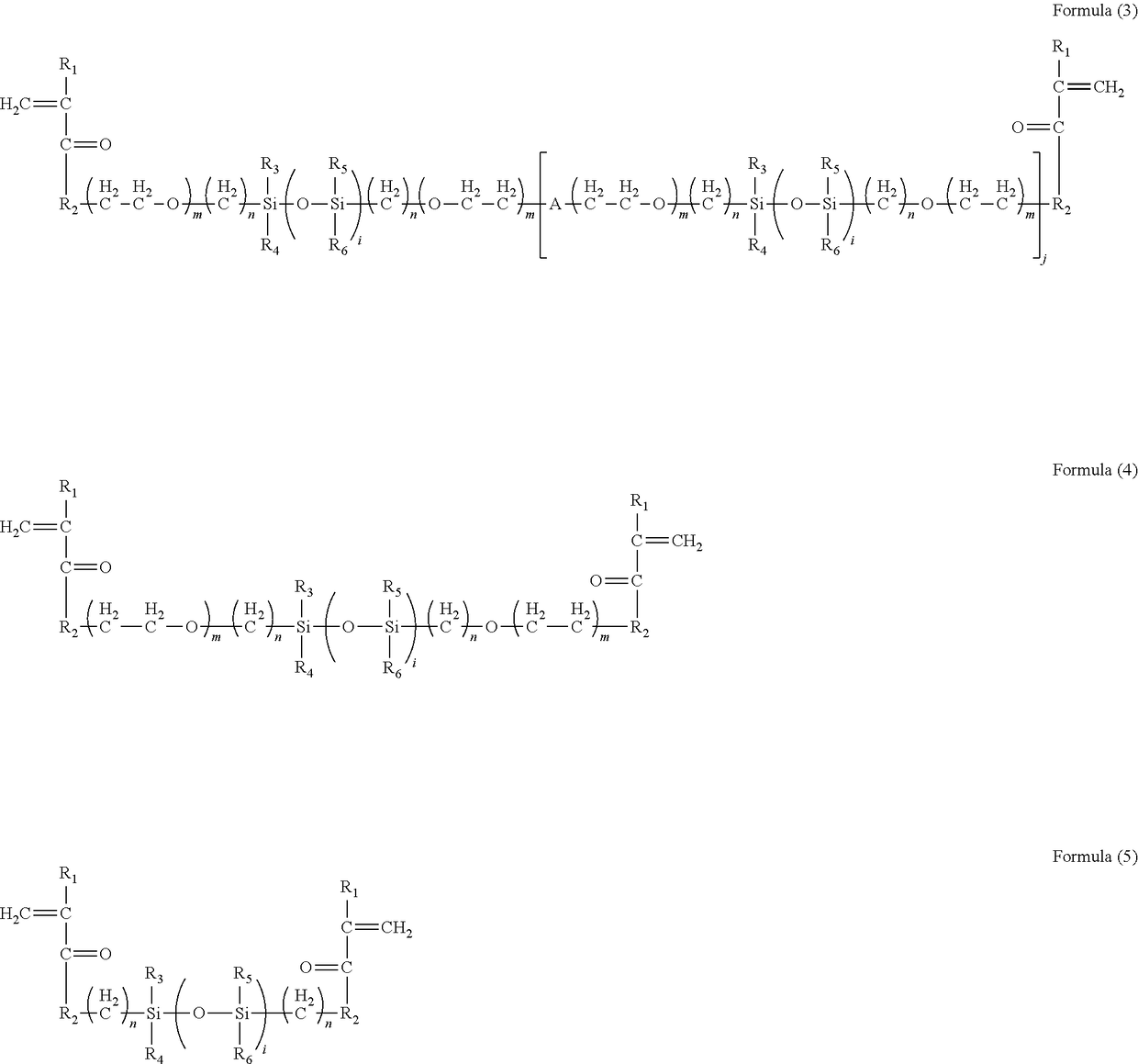Silicone hydrogel composition and lenses made of the composition
a technology applied in the field of composition and composition, can solve the problems of improving the mechanical properties of contact lenses made by conventional methods, and achieve the effects of low young's modulus, high moisture, and high oxygen permeability
- Summary
- Abstract
- Description
- Claims
- Application Information
AI Technical Summary
Benefits of technology
Problems solved by technology
Method used
Image
Examples
embodiment 1
[0042]In Embodiment 1 of the present disclosure, the constituents and weight percentages thereof in the silicone hydrogel composition are shown below.
Embodiment 1Weight percentageFirst silicon compound (SiGMA)48.3Hydrophilic monomer (HEMA)18.6Hydrophilic monomer32.7(DMA + NVP)Crosslinking agent (EGDMA)0.4Initiator (1173)0.7
[0043]In Embodiment 1 of the present disclosure, the weight percentages of the hydrophilic monomers DMA and NVP in the silicone hydrogel composition were varied, and as shown in the following table, the water content, Young's modulus and oxygen permeability coefficient of the lens were measured. The lens made of the silicone hydrogel composition of Embodiment 1 was used, and when the weight percentage of DMA to (DMA+NVP) is controlled to be more than 12.5%, the water content of the lens was not less than 47%, the Young's modulus of the lens was not more than 0.85 MPa, and the Dk value of the lens was not less than 50. It is known that when the Young's modulus of t...
embodiment 2
[0044]In Embodiment 2 of the present disclosure, the constituents and weight percentages thereof in the silicone hydrogel composition and the functional groups of the second silicon compound (Formula (1)) are shown in the following table in detail.
Embodiment 2Weight percentageFirst silicon compound (SiGMA)26.9Hydrophilic monomer (HEMA)15.4Hydrophilic monomer29.8(DMA + NVP)Crosslinking agent (EGDMA)1Initiator (1173)0.7Second silicon compound26.9(Formula (1))R1CH3R2OR3OSi(CH3)3R4OSi(CH3)3R5CH3R6CH3R7CH3n3i1
[0045]In Embodiment 2 of the present disclosure, the weight percentages of the hydrophilic monomers DMA and NVP in the silicone hydrogel composition were varied, and as shown in the following table, the water content, Young's modulus and oxygen permeability coefficient of the lens were measured. The lens made of the silicone hydrogel composition of Embodiment 2 was used, and when the weight percentage of DMA to (DMA+NVP) is controlled to be more than 12.5%, the water content of the ...
embodiment 3
[0046]In Embodiment 3 of the present disclosure, the constituents and weight percentages thereof in the silicone hydrogel composition and the functional groups of the second silicon compound (Formula (2)) are shown in the following table in detail.
Embodiment 3Weight percentageFirst silicon compound (SiGMA)26.9Hydrophilic monomer(HEMA)15.4Hydrophilic monomer29.8(DMA + NVP)Crosslinking agent (EGDMA)1Initiator (1173)0.7Second silicon compound26.9(Formula (2))R1CH3R2OCH2CH2NHCOOR3CH3R4CH3R5CH3R6CH3R7C4H9m1n3i12
[0047]In Embodiment 3 of the present disclosure, the weight percentages of the hydrophilic monomers DMA and NVP in the silicone hydrogel composition were varied, and as shown in the following table, the water content, Young's modulus and oxygen permeability coefficient of the lens were measured. The lens made of the silicone hydrogel composition of Embodiment 3 was used, and when the weight percentage of DMA to (DMA+NVP) is controlled to be more than 12.5%, the water content of th...
PUM
| Property | Measurement | Unit |
|---|---|---|
| Fraction | aaaaa | aaaaa |
| Fraction | aaaaa | aaaaa |
| Fraction | aaaaa | aaaaa |
Abstract
Description
Claims
Application Information
 Login to View More
Login to View More - R&D Engineer
- R&D Manager
- IP Professional
- Industry Leading Data Capabilities
- Powerful AI technology
- Patent DNA Extraction
Browse by: Latest US Patents, China's latest patents, Technical Efficacy Thesaurus, Application Domain, Technology Topic, Popular Technical Reports.
© 2024 PatSnap. All rights reserved.Legal|Privacy policy|Modern Slavery Act Transparency Statement|Sitemap|About US| Contact US: help@patsnap.com










